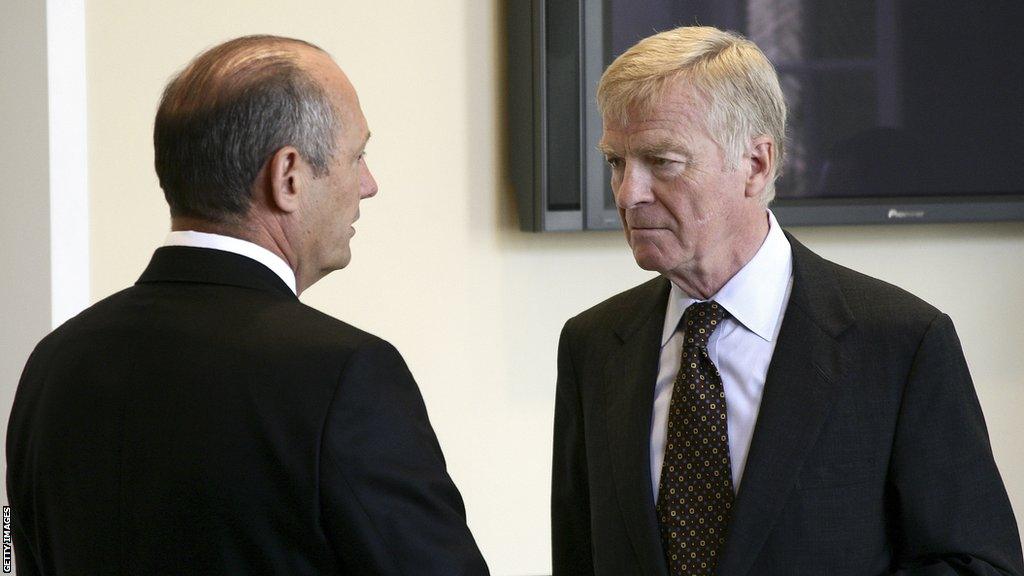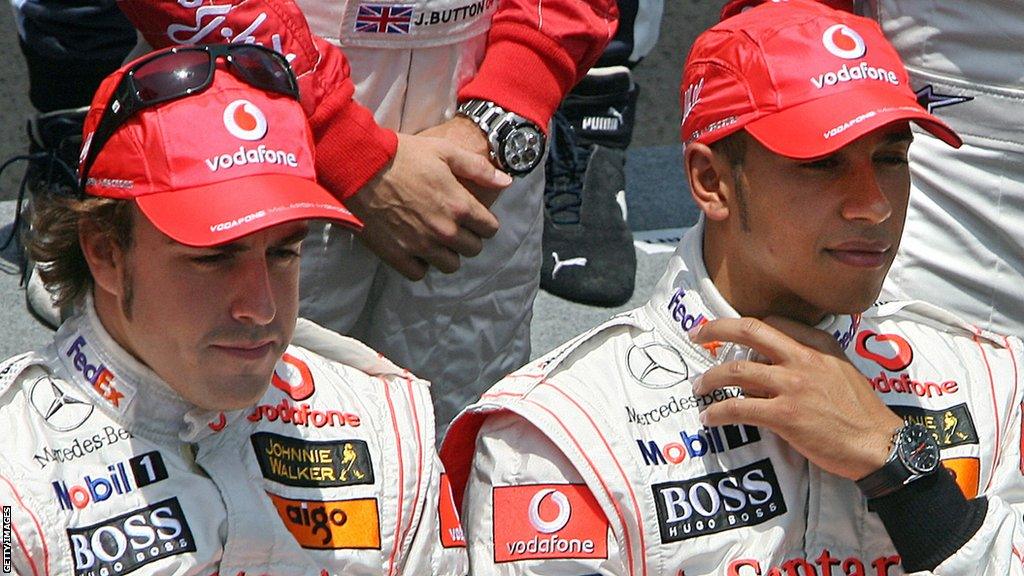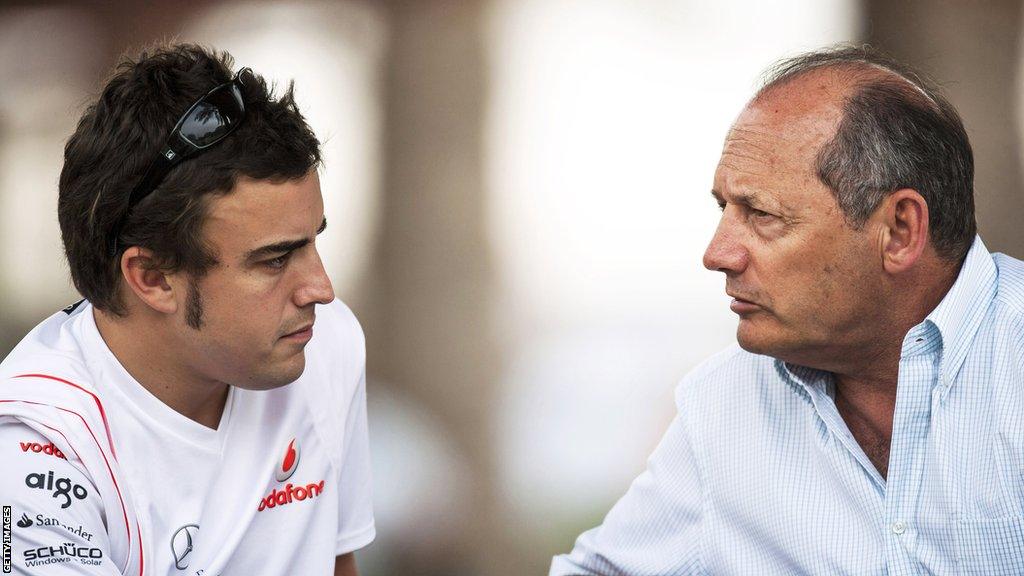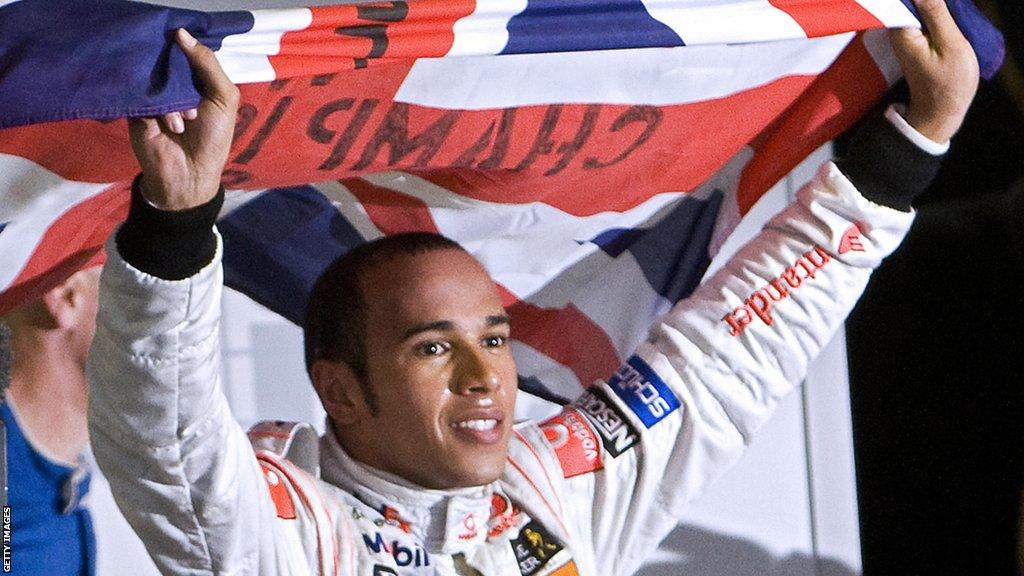F1 'spygate': Fifteen years on from the sporting scandal that had everything
- Published

Ron Dennis was McLaren boss at the time of the 'spygate' scandal, while Max Mosley was president of the sport's governing body
It was the sporting scandal that had everything. Vengeance, vindictiveness and ambition. Blackmail, secrecy, and the offence that gave it its name - spying.
It convulsed Formula 1, nearly broke one of its most famous teams and, seven years after its conclusion, the man at the heart of it died in unexplained circumstances.
This was 2007's 'spygate' scandal. It happened 15 years ago, and its effects are arguably still being felt today.
It is the subject of a new podcast series produced by BBC Sounds. Part of the Sport's Strangest Crimes brand, 'Spygate' is narrated by DJ Pete Tong and is full of interviews providing insight and anecdotes from those at the heart of the story, and those who had a front-row seat as the drama unfolded.
Among the highlights of the series are:
Former F1 designer Mike Gascoyne recounting how he stumbled across the two main protagonists in the story having a meeting in a Barcelona restaurant;
A senior Ferrari figure describing the "bomb" that went off inside the team when the scandal first came to light;
Insight from lawyers involved in the hearings;
An exclusive interview with Flavio Briatore - confidant of Fernando Alonso and Renault team boss at the time.
The outline of 'spygate' is well known but, sketching it out a decade and a half later, remains remarkable.
A disgruntled employee at the sport's most famous team, Ferrari, felt passed over and let down. His response was to steal nearly 800 pages of confidential technical information and give it to a friend who worked for their biggest rivals, McLaren.
The friend wanted a copy. So - and this fact still beggars belief - his wife took it to a local photocopy shop. The employee at the desk smelt a rat, emailed Ferrari, and that was the beginning of a series of explosive events that led to McLaren being fined an unprecedented $100m and thrown out of that year's constructors' championship., external
Why was the fine so big? That's where the vengeance and vindictiveness come in, for at the heart of this story are big rivalries involving big personalities.
The most high-profile were Max Mosley and Ron Dennis.
Mosley was the president of the sport's governing body, the FIA, whose job it was to mete out punishments for the offences in question; Dennis the boss of McLaren.
They had a mutual distaste, and had done for 30 years. Mosley saw this as an opportunity to inflict harm on Dennis so big that it might drive him out of the sport.
And all this was the backdrop to an intense sporting rivalry, in which Dennis was also deeply involved.
Alonso and Lewis Hamilton were team-mates at McLaren - one brand new to the sport, the other brand new to the team, whom he had joined right after winning two consecutive world championships with Renault, and ending the dominance of Michael Schumacher and Ferrari.
The competitive intensity of their rivalry as they went head-to-head for the championship against Ferrari drivers Kimi Raikkonen and Felipe Massa, with the off-track drama increasing the pressure alongside it, almost tore McLaren apart.

Alonso and Hamilton are both still racing 15 years on from 'spygate'

The man at the centre of 'spygate' was Nigel Stepney - an Englishman who had been chief mechanic at Ferrari during the years in which they ruled F1 with Schumacher.
As the 'dream team' of Schumacher, team principal Jean Todt, technical director Ross Brawn and chief designer Rory Byrne broke up at the end of 2006, Stepney felt not only that he was owed a promotion - in recognition of what he perceived to be his central role in turning the team into such a powerful force - but that he had been promised one.
When he did not get a role that matched his ambitions, he took action - by secreting out of the factory 780 pages of confidential information; essentially, the blueprints for the 2007 Ferrari F1 car.
He gave them to his friend Mike Coughlan - then chief designer of McLaren - and together they hatched a plan to try to get jobs at another team.
Their plan unravelled after Coughlan's wife Trudy went into a photocopy shop in Woking and asked for copies of the documents. The owner - a Ferrari fan, believe it or not - was immediately suspicious. He emailed Ferrari, and the saga began.
When Ferrari found out, it only confirmed the suspicions they already had about Stepney.
The photocopy shop incident happened in early June. Stepney had already been suspended by Ferrari the previous month, with the team saying they had evidence he had tried to sabotage one of the F1 cars at the factory before the Monaco Grand Prix - something Stepney always denied.
Soon, the situation went legal - in the Italian and UK courts, and with the F1 authorities.
McLaren were cleared of wrongdoing at a first hearing held by governing body the FIA, on the grounds Coughlan had acted alone, without the knowledge of the team.
But Mosley still had suspicions, and at a second hearing it was held that the information had reached others in the team. McLaren were fined $100m and thrown out of the constructors' championship for illicitly holding information to confer a dishonest and fraudulent sporting advantage, although there was no finding they had actually used the information in the design or development of their cars.

How the second hearing happened is where the drivers come in.
Alonso had gone to McLaren expecting to be their number one driver and title contender - indeed, he believed he had been promised that status by Dennis, something the team boss always denied.
Hamilton, who was in his debut season, was known to be promising, but he caused a sensation with a stunning start to his F1 career, and his pace and competitiveness upset the balance in the team.
Alonso's competitive nature was triggered. He believed a British driver in a British team with a British boss was a situation in which he would be sidelined.
And when Dennis mishandled his two drivers after they finished one-two at Monaco - Alonso ahead, having led the race throughout from pole, Hamilton believing he had been denied a fair crack air trying to beat him, and not troubling to hide it - Alonso's relationship with Dennis fractured.

Alonso (left) won both of his world titles before joining McLaren in 2007
There was worse to come. At the Hungarian Grand Prix later that summer, Hamilton double-crossed Alonso in qualifying - refusing to follow an arrangement to let him by, and compromising the Spaniard's chances of pole.
Alonso immediately took matters into his own hands. When both drivers pitted for their final set of tyres, Alonso held station in the pit lane just long enough to prevent Hamilton, waiting behind, getting out in time for a final lap.
Dennis was furious, the matter went to the stewards, and Alonso was given a five-place grid penalty. Now Alonso, too, was furious. He had a row with Dennis on the Sunday morning before the race.
It wasn't fair he had been punished when Hamilton had started it, he felt. McLaren were going to lose the championship to a Ferrari driver if they kept fighting among themselves, he said. He had been promised he would be team leader.
And then came the nuclear moment - he demanded McLaren run Hamilton out of fuel in the race. If they didn't, he said, he would hand over emails pertinent to the spy case to the FIA.
Dennis wanted to sack Alonso on the spot. His right-hand man Martin Whitmarsh agreed. Dennis phoned Mosley to tell him of Alonso's threat, insisting the emails would reveal nothing damaging. Mosley talked him out of dismissing Alonso.
It has been widely believed that Dennis' call directly led to the second FIA hearing. But Mosley, who died last year, said this was not the case. He already knew about the emails, he told this writer - Briatore, Alonso's manager, had told Bernie Ecclestone, who had told Mosley - and the hearing was already inevitable, even if Dennis did not know it.
Alonso, meanwhile, apologised and withdrew his remarks. Dennis - believing the email story was therefore untrue - rang Mosley for a second time. But it was too late.

Stepney was found guilty by an Italian court of "sabotage, industrial espionage, sporting fraud and attempted serious injury", and given a prison sentence of a year and eight months, although he served no time behind bars.
He was also declared persona non grata by the FIA, which issued a statement advising teams not to hire him without conducting appropriate due diligence.
He continued to work in motorsport, but his time in F1 was over. In May 2014, he was killed in a road-traffic accident on the M20 motorway in Kent, having strayed on foot into the carriageway from his stopped vehicle and been hit by a lorry. A coroner recorded an open verdict on his death.
As for McLaren, Dennis railed that the punishment was out of all proportion to the alleged 'crime', which he insisted the team were not guilty of anyway.
F1 folklore has it that in a staged photo-opportunity at the race after the verdict was handed down, Mosley leant across to Dennis and said $5m of the fine was for "what you did" and the other $95m for being a four-letter word we won't repeat.
Mosley denied he had said it at the time, insisting that the remarks were something Ecclestone had said to him about Dennis. Regardless, Mosley would delight in regularly telling the story, clearly finding the idea amusing, whether he was its author or not.
The fine initially appeared to have left McLaren undamaged - Hamilton and Alonso did lose the championship that year, both missing out to Raikkonen by a single point, but Hamilton went on to win his maiden title the following season in 2008.

Hamilton is now a seven-time world champion
In fact, though, the fallout was significant and long-lasting.
Mercedes was then McLaren's partner and engine supplier, and as a 40% shareholder had to pay its share of the fine - $40m.
Trust between the two was damaged, and it was knocked further when Dennis embarked on building the second McLaren road car - the MP4-12C - against the wishes of Mercedes, who felt it would be a rival to their high-end products.
Then, in 2009, McLaren produced their worst F1 car for years, and had a terrible season. The title was won by Brawn - set up by Stepney's former boss - from the ashes of Honda's team, after the Japanese manufacturer quit F1 at the end of 2008.
Brawn were using a Mercedes engine - a deal Whitmarsh was instrumental in putting together.
As head of the F1 Teams' Association - effectively a union to counter what the teams saw as Mosley's increasingly authoritarian methods - he saw it as his responsibility to help save the team following Honda's withdrawal.
That set up a relationship between Mercedes and Brawn, who were running hand-to-mouth, struggling for income and heading towards collapse as the season went on.
As Mercedes' feelings towards McLaren cooled - as a result of spy-gate, of the road-car programme, of their lack of competitiveness - they began to think about going it alone.
They decided that for more or less the same investment, they could have their own team, with more exposure and total control. Brawn was the obvious vessel but McLaren, as exclusive partner, still had to sign off on the arrangement.
And so began the Mercedes team, which from 2014 was to dominate F1 for three-quarters of a decade as the sport entered its new era of turbo-hybrid engines.
From 2010, McLaren were no longer Mercedes' sole focus, and after 2012 they lost 'works' status and had to start paying for their engines. They were title contenders in 2010 and 2012, but by 2013 they had fallen from competitiveness, and their resources began slowly to fall behind those of the top teams.
In 2014, McLaren were two seconds off the pace, and from 2015 they lost Mercedes engines altogether, beginning a disastrous relationship with Honda, which ended after only three years.
And in 2017, Dennis was ousted from the team he had made great, having fallen out with his long-time partner and former friend Mansour Ojjeh.
A recovery process was begun under new management - part of which has been a return to being a Mercedes engine customer since 2021. They finally won a race again last year - nine years after their previous victory - but are still a long way from the competitive force they were.
And all that has its roots in spygate, and the events triggered by one man, who is no longer around to explain why he started one of the greatest scandals sport has ever known.

Messi as you've never seen him before: A wide-reaching documentary about the legendary footballer
MOTD Top 10 World Cup 2022: A countdown of the greatest World Cup goals

